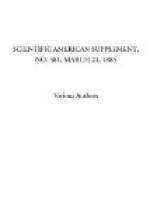Now, considering that Franklin made his discovery in 1752, and the United States were not formed till about thirty years afterward, it is rather “transmogrifying” history to say the lightning was tamed in the United States.
Again, where the notice about Professor Morse was put, they say that the instrument was invented by Morse in 1846, while alongside it is shown the very slip which sent the message, dated 1844; so that the slip of the original message sent by Morse was sent by his instrument two years before it was invented.
Again, that favorite old instrument of ours which we are so proud of, the hatchment telegraph of Cooke and Wheatstone, invented in 1837, was labeled “Whetstone and Cook, 1840,” so while I am sorry to say they are loose in their history, they are tight in their friendships, and all the visitors receive the warmest possible welcome from them generally, and especially so from every member of our Society belonging to the States.
* * * * *
THE HOUSE OF A THOUSAND TERRORS, ROTTERDAM.
[Illustration: THE HOUSE OF A THOUSAND TERRORS, ROTTERDAM.]
This building, which is situated at the corner of the Groote Market and the Hang, is one of the oldest houses in Rotterdam, besides being one of the most interesting from a historical point of view. There is a tradition which states that when the city was invaded and pillaged by the Spaniards, who in accordance with their usual custom, proceeded to put the inhabitants to the sword, without regard to age or sex, a large number of the leading citizens took refuge within the building, and having secured and barricaded the entrance, they killed a kid and allowed the blood to flow beneath the door into the street; seeing which the soldiery concluded that those inside had already been massacred, and without troubling to force an entry passed on, leaving them unmolested. Here the unhappy citizens remained for three days without food, by which time the danger had passed away, and they were enabled to effect their escape. It is from this incident that the building takes its name. The house is built in a species of irregular bond with bricks of varying lengths, the strings, labels, copings, etc., being in stone. The upper portion remains in pretty much the same condition as it existed in the 16th century, but is much disfigured by modern paint, which has been laid over the whole of the exterior with no sparing hand. Within the last few years the present shop windows facing the Groote Market have been put up and various slight alterations made to the lower part of the building to suit the requirements of the present occupiers. The drawing has been prepared from detail sketches made on the spot.—W.E. Pinkerton, in Building News.
* * * * *




